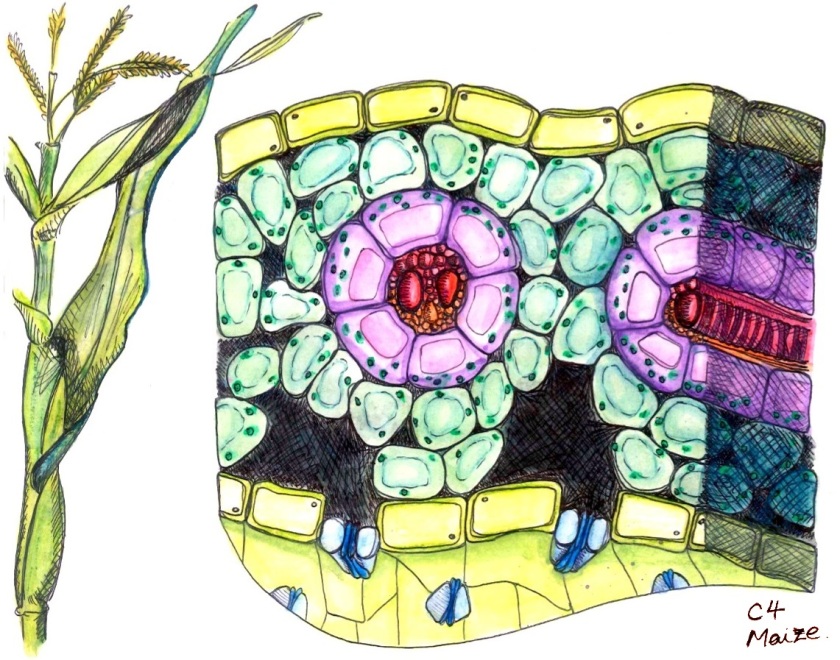Evolution of C4 pathway of photosynthesis added additional teeth to this life sustaining process enhancing plant’s ability to better scrub our atmosphere from CO2 resulting in higher biomass. These characteristics of C4 plants make them attractive to solve food security problems by enhancing biomass production of high value C3 crops like rice.
The major difference between these plants lies in leaf anatomy. C4 plants compartmentalise their photosynthesis and used both compartments for fixing carbon thus accounting for greater carbon accumulation into biomass. This anatomical modification is known as Kranz anatomy. Simply explained, the plant fixes carbon twice once in the outer cells and the second time in the inner sheath cells as against a single fixation in C3 plants. Thus changing a C3 plant to C4 would involve some sort of anatomical modification that could allow for such efficient fixation to occur in our C3 crops thus potentially increasing yields.

Fig: Cross section of Maize leaf showing Kranz anatomy
A key way to do this is increase the volume of key organelles of sheath cells in C3 plants. These organelles are the chloroplast (responsible for photosynthesis) and mitochondria (produces energy to the cell). This anatomic shift is called ‘proto-kranz’ anatomy.
Recently Wang and colleagues published results from their experiment where they were able to bring about such an effect in the sheath cells of rice leaf using GOLDEN2-LIKE genes from Maize (http://dx.doi.org/10.1016/j.cub.2017.09.040). Initial attempts at this were semi successful as the anatomical effects were only maintained until the seedling stages but was suppressed there after. The maize genes were postulated by the authors to be able to over come this short life span of the proto-kranz anatomy.
First, to overcome the problem of sustaining the anatomy the genes were introduced at such positions in the genome of rice such that it is continuously active. The impact of this was immediately apparent by appearance of green cali (small bundle of cells). Second this modification resulted in increased chloroplast volume and enhanced mitochondrial function and size, confirmed by electron microscopy and increased photo-respiratory enzymes respectively. This anatomical cellular change is one of the first evolutionary steps towards developing of C4 anatomy.
So does this mean that we now have a high yielding rice species to address food security?
No.
A comparison between these lab reared modified plants to those in the wild revealed very similar photosynthetic rates and at whole plant level yields. The significance of this effort is at a more subtle evolutionary level.
The amazing finding here is that a modification of a single gene brought about this switch towards C4 way of life. This discovery makes convergent evolution less mysterious in terms how it happens. The modification also doesn’t prove costly for the plant in terms of fitness in terms of yield thus letting it compete in nature.
In many ways this simple modification with such far reaching impact shows how simple yet elegant biological evolution can be.
